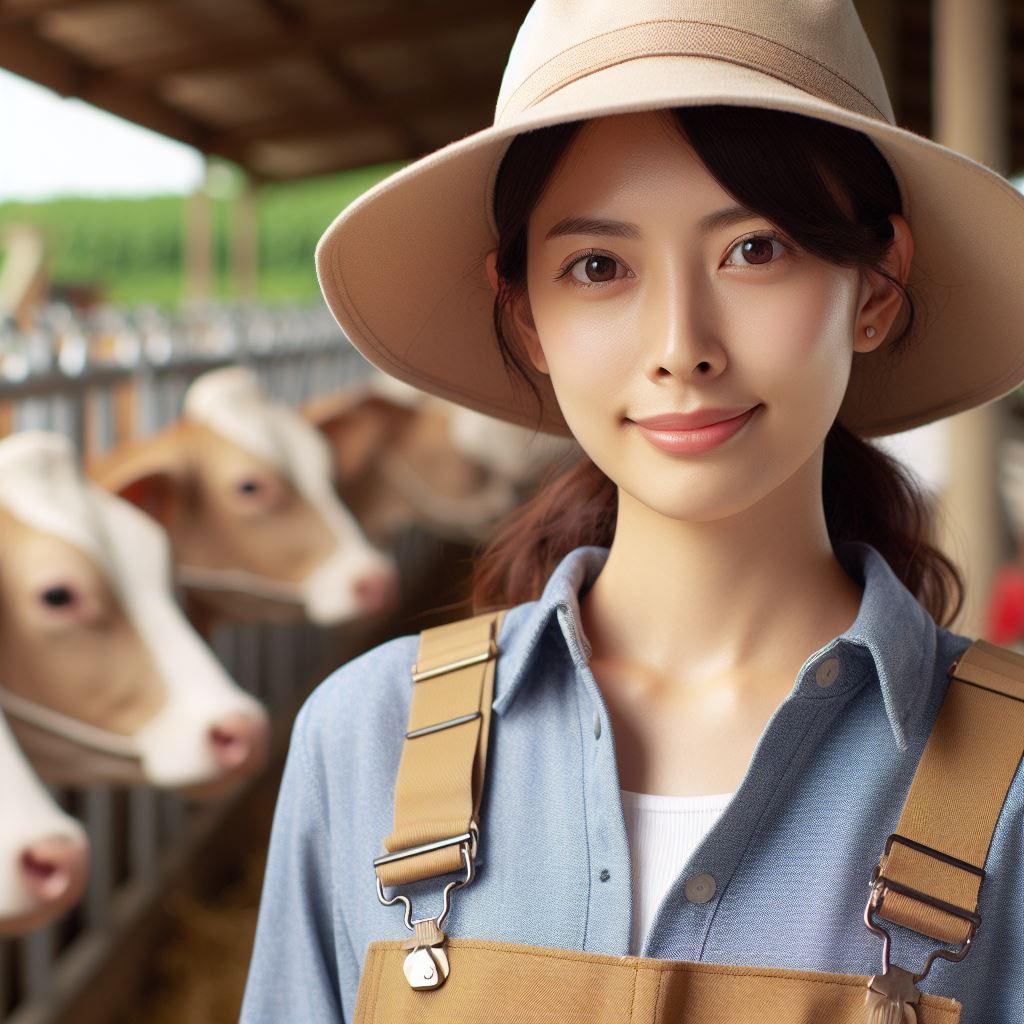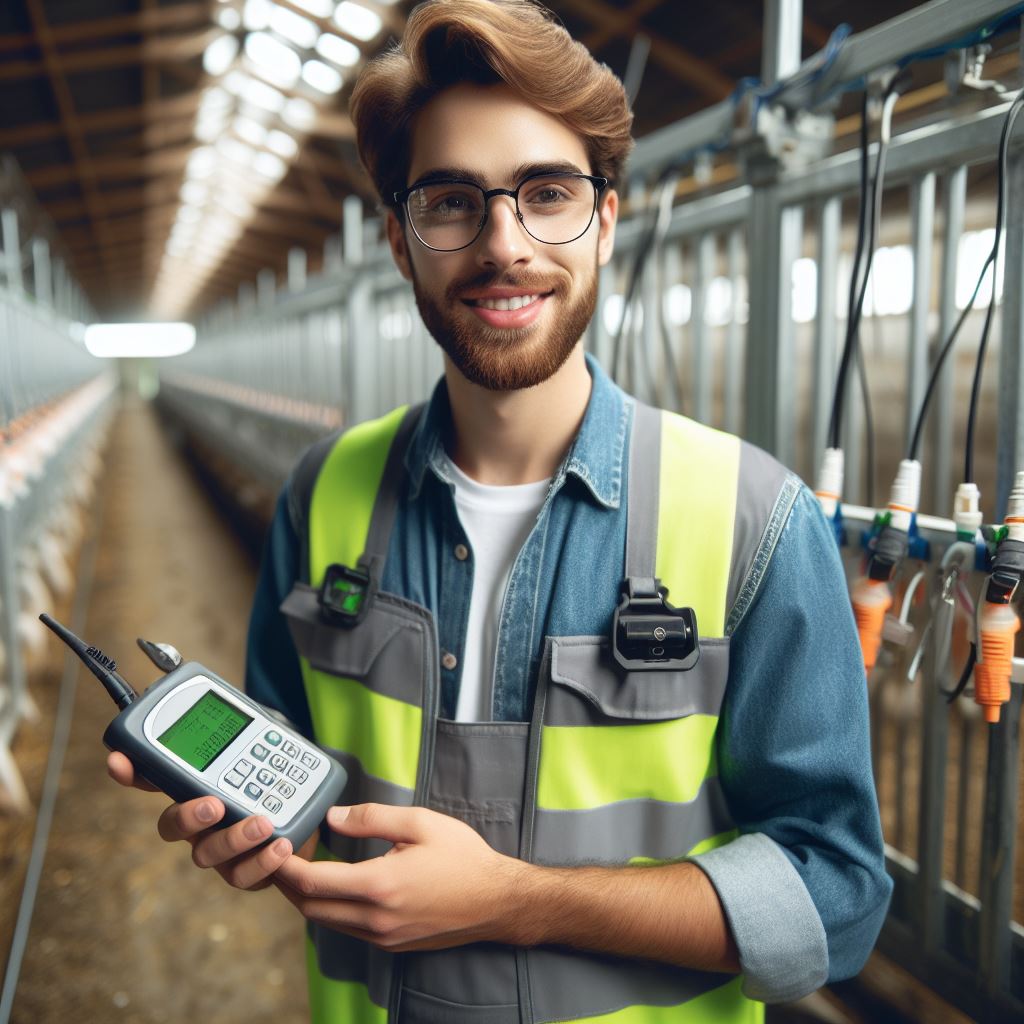Introduction
In the world of agriculture, the use of eco-friendly livestock equipment has become increasingly important.
Farmers and ranchers are seeking ways to reduce their environmental impact while still maintaining productivity.
This blog section will explore the importance of eco-friendly livestock equipment and provide a brief overview of the topic.
Importance of eco-friendly livestock equipment
Eco-friendly livestock equipment plays a vital role in sustainable farming practices.
It allows farmers to minimize their carbon footprint, reduce waste, and promote animal welfare.
By utilizing equipment that is designed with the environment in mind, farmers can contribute to the preservation of natural resources and the overall health of the planet.
Brief overview of the topic
Advancements in technology have opened up new possibilities for eco-friendly livestock equipment.
From energy-efficient feeding systems to waste management solutions, the industry has seen a surge in innovation.
These new tools and practices not only benefit the environment but also improve the efficiency and productivity of farming operations.
One area of focus has been on reducing water usage through the development of innovative watering systems.
These systems ensure that livestock have access to clean water while minimizing water waste.
Eco-friendly feeding systems have been developed, which help optimize feed distribution, reduce food waste, and decrease energy consumption.
Another aspect of eco-friendly livestock equipment is the integration of renewable energy sources.
Solar panels and wind turbines are being used to power farm operations and reduce reliance on fossil fuels.
This shift towards renewable energy not only decreases greenhouse gas emissions but also offers economic benefits for farmers in the long run.
Transform Your Agribusiness
Unlock your farm's potential with expert advice tailored to your needs. Get actionable steps that drive real results.
Get StartedIn general, the use of eco-friendly livestock equipment is essential for modern farming practices.
It not only helps preserve the environment but also offers numerous economic and efficiency benefits.
By adopting these advancements, farmers can contribute to a more sustainable future while still meeting the needs of their livestock and ensuring the success of their operations.
Benefits of Eco-Friendly Livestock Equipment
In recent years, there has been growing interest in eco-friendly livestock equipment.
This section explores the benefits of using such equipment, including a reduction in environmental impact, improved animal welfare, and long-term cost-effectiveness.
Reduction in environmental impact
Eco-friendly livestock equipment helps minimize the environmental footprint of farming practices.
These tools and technologies aim to reduce energy consumption, water usage, and greenhouse gas emissions associated with livestock production.
- Energy-efficient lighting and heating systems significantly reduce electricity consumption in livestock facilities.
- Advanced manure management systems help convert waste into renewable energy, minimizing greenhouse gas emissions.
- Water-saving technologies, such as efficient watering systems and rainwater harvesting, reduce water usage on farms.
Improved animal welfare
Using eco-friendly equipment can greatly enhance the well-being of livestock.
For example, advanced ventilation systems promote better air quality, reducing the risk of respiratory diseases.
Comfortable and ergonomic facilities can also reduce stress levels and promote healthier growth in animals.
- Well-designed and ventilated barns ensure proper air circulation and control temperature and humidity levels.
- Comfortable flooring, such as rubber mats or deep-bedded systems, provide cushioning and reduce injuries.
- Automatic feeding and watering systems ensure animals have access to food and water at all times.
- Enrichment tools, like scratching posts or toys, help alleviate boredom and encourage natural behaviors.
Cost-effectiveness in the long run
While upfront costs of eco-friendly livestock equipment may be slightly higher, they offer significant long-term financial benefits.
Energy-efficient tools can help lower utility bills, while automated systems reduce labor costs.
Improved animal health and productivity can lead to higher profits in the long term.
- Energy-efficient equipment, such as LED lights and solar panels, lower electricity bills and provide a return on investment over time.
- Automated feeding and watering systems reduce labor costs and ensure optimal nutrient intake for livestock.
- Advanced waste management systems help generate biogas, reducing dependence on external energy sources.
- Healthier animals result in reduced veterinary expenses and increased productivity and profitability.
It’s essential for farmers to adopt eco-friendly livestock equipment in order to promote sustainable farming practices.
These technologies not only contribute to environmental conservation but also enhance animal welfare and farm profitability.
Generally, the benefits of eco-friendly livestock equipment are numerous and diverse.
By investing in such equipment, farmers can reduce their environmental impact, improve animal welfare, and achieve long-term cost-effectiveness.
Embracing these innovations is a win-win solution for both farmers and the planet.
Read: Profitable Pig Marketing Strategies
Advanced Feeders and Waterers
When it comes to eco-friendly livestock equipment, there are several exciting advancements happening in the industry.
One area of focus is on advanced feeders and waterers that aim to improve efficiency and reduce waste.
Let’s take a closer look at some of these new developments:
Use of Automatic Systems for Feed Dispensing
Traditional feeding methods can result in overfeeding or inconsistent feeding schedules.
However, with the use of automatic systems, farmers can ensure that their livestock receive the right amount of feed at the right time.
Showcase Your Farming Business
Publish your professional farming services profile on our blog for a one-time fee of $200 and reach a dedicated audience of farmers and agribusiness owners.
Publish Your ProfileThese systems can be programmed to dispense specific quantities of feed, reducing waste and minimizing the risk of overconsumption.
Waterers that Minimize Water Wastage
Water is a precious resource, and agricultural practices can sometimes lead to its excessive use.
Thankfully, new waterer designs are addressing this issue by minimizing water wastage.
For example, some waterers have built-in sensors that detect when animals are not drinking and automatically shut off the water supply.
This prevents unnecessary water loss and promotes responsible water usage.
Benefits of Reducing Labor and Improving Efficiency
The adoption of advanced feeders and waterers brings numerous advantages to livestock farmers.
By automating feed dispensing and water supply, farmers can significantly reduce manual labor.
This not only saves time but also allows farmers to allocate their resources elsewhere.
These systems improve overall efficiency by providing a consistent and reliable food and water supply to the livestock.
Now that we’ve explored the advancements in eco-friendly livestock equipment, let’s delve into the benefits they offer:
- Reduced Feed and Water Waste: The use of automatic feeders and waterers minimizes wastage by ensuring precise amounts are dispensed. This reduces unnecessary expenditure on feed and lowers the environmental footprint associated with feed production.
- Improved Animal Health and Nutrition: With automated systems, livestock receive consistent and timely access to feed and water.
This promotes better nutrition and overall health, which translates into improved growth rates, reproductive performance, and disease resistance. - Enhanced Animal Welfare: Livestock that have access to a consistent and reliable food and water supply experience less stress.
This leads to improved animal welfare, as they are not subjected to hunger or thirst. Automatic systems can be designed to promote natural feeding behaviors, such as grazing in smaller, more frequent portions. - Time and Labor Savings: By eliminating the need for manual feeding and watering, farmers can reallocate their time and resources to other farm activities. This can include focusing on animal health monitoring, pasture management, or implementing additional sustainable practices.
- Environmental Sustainability: The reduced waste and optimized resource usage associated with advanced feeders and waterers contribute to the overall sustainability of livestock operations. By minimizing water consumption and feed waste, farms can decrease their ecological impact and conserve natural resources.
Basically, the emergence of advanced feeders and waterers is revolutionizing the livestock industry.
These eco-friendly solutions not only reduce waste and improve efficiency but also bring numerous benefits to animal welfare and the environment.
As farmers embrace these advancements, they can look forward to a more sustainable and profitable future for their livestock operations.
Read: Profitable Pig Marketing Strategies
Sustainable Housing and Bedding Options
Introduction to Eco-Friendly Materials
Livestock equipment has come a long way in terms of sustainability and eco-friendliness.
With growing concerns about the environmental impact of traditional livestock farming practices, farmers and manufacturers have been actively seeking alternative materials and designs to minimize their carbon footprint.
One of the key aspects of sustainable livestock equipment is the choice of materials.
Traditional materials like concrete and metal have been replaced with eco-friendly options such as recycled plastics, bamboo, and reclaimed wood.
These materials not only reduce the environmental impact but also provide durability and functionality.
Innovative Housing Designs that Promote Animal Well-being
Besides the choice of eco-friendly materials, there have been significant advancements in housing designs that prioritize animal well-being.
Animal comfort and health are crucial for optimal production and overall farm sustainability.
One such design innovation is the use of open-air housing systems.
These systems provide ample ventilation and natural light, reducing the need for artificial heating and lighting.
Open-air housing not only enhances the animals’ living conditions but also minimizes energy consumption and greenhouse gas emissions.
Another promising design approach is the implementation of modular housing systems.
These systems allow for easy customization and adaptability, ensuring that livestock housing can be tailored to specific farm sizes and needs.
It enables efficient space utilization and reduces wastage, making it an environmentally friendly choice.
Benefits of Using Natural Bedding Alternatives
In addition to sustainable housing options, the choice of bedding materials also plays a significant role in eco-friendly livestock equipment.
Traditional bedding materials like straw and sawdust have been a staple, but they can be resource-intensive and require constant replenishment.
Natural bedding alternatives, such as hemp or recycled paper products, offer several benefits.
These materials are renewable, biodegradable, and require less water and energy during production.
They also provide comfort, absorbency, and odor control, ensuring a healthier environment for the animals.
Using natural bedding alternatives contributes to waste management on the farm.
These materials can be composted, reducing the need for additional waste disposal methods and promoting soil health.
Ultimately, the development of sustainable housing and bedding options for livestock equipment is a positive step towards reducing the environmental impact of agriculture.
By choosing eco-friendly materials and innovative designs, farmers can achieve both animal well-being and operational efficiency.
The use of eco-friendly materials, such as recycled plastics, bamboo, and reclaimed wood, ensures durability and functionality while reducing the carbon footprint.
Innovative housing designs, like open-air systems and modular structures, prioritize animal comfort and minimize energy consumption.
Additionally, opting for natural bedding alternatives like hemp or recycled paper products not only benefits the animals but also contributes to waste management and soil health.
As the agricultural industry continues to evolve, it is crucial for farmers and manufacturers to embrace these eco-friendly practices and invest in sustainable livestock equipment.
Showcase Your Farming Business
Publish your professional farming services profile on our blog for a one-time fee of $200 and reach a dedicated audience of farmers and agribusiness owners.
Publish Your ProfileBy doing so, they can contribute to a more sustainable future and ensure a healthier environment for both animals and humans alike.
Read: Profitable Pig Marketing Strategies

Energy-Efficient Lighting
Implementation of LED lights for energy conservation
One of the latest developments in eco-friendly livestock equipment is the implementation of energy-efficient lighting systems.
By utilizing LED lights, farmers can significantly reduce their energy consumption.
LED lights are known for their low energy consumption and long lifespan.
They use up to 75% less energy compared to traditional incandescent lighting, making them an ideal choice for livestock facilities.
These lights also emit less heat, reducing the need for additional cooling systems.
This not only saves energy but also creates a more comfortable environment for the animals.
Ventilation Systems
In addition to energy-efficient lighting, farmers are also adopting ventilation systems that improve air quality without excessive energy consumption.
These systems ensure proper airflow and contribute to a healthier environment for the livestock.
Smart ventilation systems use sensors to detect temperature, humidity, and air quality levels.
By analyzing these factors, the system automatically adjusts ventilation rates, optimizing energy usage without compromising animal comfort.
These systems also help reduce the spread of diseases by controlling the buildup of pathogens and improving overall air quality within the facility.
Impacts on Animal Health and Productivity
The implementation of energy-efficient lighting and ventilation systems has numerous benefits for animal health and productivity.
Lighting plays a crucial role in regulating the circadian rhythm of livestock, directly impacting their growth, reproduction, and overall well-being.
The use of LED lights allows farmers to provide a more natural lighting environment for the animals, mimicking the conditions they would experience in the wild.
This helps maintain the animals’ biological functions and promotes better growth rates and reproductive performance.
Proper ventilation is another critical factor in ensuring optimal animal health and productivity.
By improving air quality, ventilation systems reduce the risk of respiratory diseases and other health issues that can impact the animals’ growth and productivity.
A comfortable and stress-free environment created by efficient ventilation systems can help reduce animal stress levels, resulting in improved welfare and higher productivity.
Overall, the adoption of energy-efficient lighting and ventilation systems in livestock facilities is a significant step towards minimizing the environmental impact of agriculture while maximizing animal health and productivity.
By implementing LED lights and smart ventilation systems, farmers can reduce energy consumption, improve air quality, and create a more comfortable environment for their livestock.
These advancements benefit both the farmers and the animals they care for, promoting sustainable and efficient farming practices.
Read: Profitable Pig Marketing Strategies
Waste Management and Manure Handling
Effective waste management and manure handling are essential for sustainable and eco-friendly livestock farming.
Techniques to compost and recycle manure
- Composting is a widely used and effective method to manage and recycle manure on livestock farms.
- Composting breaks down the manure into nutrient-rich organic matter that can be used as fertilizer.
- Proper composting reduces pathogens and eliminates weed seeds present in raw manure.
- Composted manure improves soil quality, increases water holding capacity, and enhances plant growth.
- Recycling manure decreases the need for synthetic fertilizers, reducing environmental pollution.
Use of anaerobic digesters for energy production
- Anaerobic digesters are advanced technologies that convert manure into biogas and renewable energy.
- They operate in an oxygen-free environment, where microorganisms break down organic materials, producing biogas.
- Biogas generated from manure can be used for heating, electricity generation, or as a vehicle fuel.
- Using anaerobic digesters reduces greenhouse gas emissions, contributing to climate change mitigation.
- It also provides a renewable and sustainable energy source, reducing dependence on fossil fuels.
Benefits of reducing waste and odor control
- Implementing proper waste management strategies helps minimize the negative impact of livestock farming.
- Reducing waste and controlling odor brings numerous benefits for both the environment and the farmers.
- Reduced waste runoff decreases water pollution and helps protect natural water sources.
- Controlling odor improves the air quality in the surrounding areas, leading to a healthier environment.
- Effective waste management also reduces the risk of disease transmission, ensuring animal and human health.
Essentially, adopting eco-friendly livestock equipment and practices is crucial for sustainable farming.
Implementing techniques like composting and recycling manure, utilizing anaerobic digesters for energy production, and reducing waste while controlling odor offer significant environmental and economic advantages.
By efficiently managing waste and manure, farmers can contribute to a greener future and mitigate the impact of livestock farming on the environment.
Technological Advancements in Monitoring and Data Collection
With the increasing focus on sustainable farming practices, the agriculture industry has witnessed significant advancements in eco-friendly livestock equipment.
One area that has seen remarkable progress is monitoring and data collection through the use of advanced technologies.
Introduction to Sensors and Data Analysis
The integration of sensors in livestock equipment has revolutionized the way farmers monitor their animals.
These sensors can track various parameters such as body temperature, heart rate, and even rumination patterns.
The data collected from these sensors is then analyzed to provide valuable insights into animal health and behavior.
Sensors in livestock equipment can be attached to various parts of the animal, such as ear tags or collars.
These sensors are equipped with GPS technology, accelerometers, and thermal sensors to capture and transmit real-time data to a centralized system.
Real-time Monitoring of Animal Health and Behavior
The real-time monitoring capabilities provided by advanced livestock equipment offer numerous benefits to farmers.
By constantly monitoring vital parameters, such as body temperature, farmers can detect early signs of illness or disease, enabling prompt intervention and minimizing the risk of spreading infections among animals.
The monitoring of animal behavior through sensors allows farmers to identify any abnormal patterns that may indicate distress or discomfort.
For instance, changes in rumination patterns can be an early indicator of digestive issues or stress, prompting farmers to take necessary actions and enhance animal welfare.
Advantages of Data-driven Decision Making in Livestock Management
The availability of real-time data on animal health and behavior empowers farmers to make informed decisions.
Showcase Your Farming Business
Publish your professional farming services profile on our blog for a one-time fee of $200 and reach a dedicated audience of farmers and agribusiness owners.
Publish Your ProfileBy analyzing the collected data, farmers can identify trends, patterns, and potential issues that might have gone unnoticed otherwise.
Data-driven decision making in livestock management helps optimize resource allocation, improve feed efficiency, and enhance overall productivity.
For instance, by closely monitoring the feeding patterns of animals, farmers can adjust the feed ration, ensuring optimal nutrition for each individual animal, thus reducing waste and costs.
The data collected can be used for predictive analytics, allowing farmers to anticipate and prevent potential problems.
This proactive approach mitigates the risk of disease outbreaks, reduces unnecessary antibiotic use, and ultimately contributes to a more sustainable and environmentally friendly livestock farming industry.
Most importantly, the integration of advanced monitoring technologies in livestock equipment has revolutionized the way farmers manage their animals.
Real-time data collection and analysis provide valuable insights into animal health and behavior, enabling informed decision making for improved productivity and sustainability in the agriculture industry.
Gain More Insights: The Role of Technology in Poultry Farming
Discover More: Boost Your Beef Cattle’s Health: Top Tips
Conclusion
Eco-friendly livestock equipment offers numerous benefits to both farmers and the environment.
It reduces emissions, minimizes waste, improves animal welfare, and enhances overall sustainability.
Recap of the benefits of eco-friendly livestock equipment
Eco-friendly livestock equipment reduces environmental impact, improves animal health, and increases overall farm sustainability.
It is a win-win solution for farmers and the planet.
Call to action for adopting sustainable practices
We urge farmers and livestock owners to embrace eco-friendly equipment and practices to contribute to a greener future.
By adopting sustainable practices, we can help reduce the carbon footprint and ensure the well-being of animals.
Encouragement to stay updated with emerging technologies in the field
As technology continues to advance, it is important for farmers and livestock professionals to stay updated with the latest eco-friendly innovations and equipment in the industry.
By keeping up with emerging technologies, we can continuously improve our farming practices and make a positive impact on the environment.




